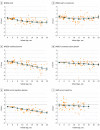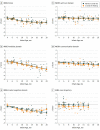Neurodevelopmental Abnormalities in Children With In Utero Zika Virus Exposure Without Congenital Zika Syndrome
- PMID: 31904798
- PMCID: PMC6990858
- DOI: 10.1001/jamapediatrics.2019.5204
Neurodevelopmental Abnormalities in Children With In Utero Zika Virus Exposure Without Congenital Zika Syndrome
Erratum in
-
Error in Figure 1.JAMA Pediatr. 2020 Mar 1;174(3):305. doi: 10.1001/jamapediatrics.2020.0174. JAMA Pediatr. 2020. PMID: 32119038 Free PMC article. No abstract available.
Abstract
Importance: The number of children who were born to mothers with Zika virus (ZIKV) infection during pregnancy but who did not have apparent disability at birth is large, warranting the study of the risk for neurodevelopmental impairment in this population without congenital Zika syndrome (CZS).
Objective: To investigate whether infants without CZS but who were exposed to ZIKV in utero have normal neurodevelopmental outcomes until 18 months of age.
Design, setting, and participants: This cohort study prospectively enrolled a group of pregnant women with ZIKV in Atlántico Department, Colombia, and in Washington, DC. With this cohort, we performed a longitudinal study of infant neurodevelopment. Infants born between August 1, 2016, and November 30, 2017, were included if they were live born, had normal fetal brain findings on magnetic resonance imaging and ultrasonography, were normocephalic at birth, and had normal examination results without clinical evidence of CZS. Seventy-seven infants born in Colombia, but 0 infants born in the United States, met the inclusion criteria.
Exposures: Prenatal ZIKV exposure.
Main outcomes and measures: Infant development was assessed by the Warner Initial Developmental Evaluation of Adaptive and Functional Skills (WIDEA) and the Alberta Infant Motor Scale (AIMS) at 1 or 2 time points between 4 and 18 months of age. The WIDEA and AIMS scores were converted to z scores compared with normative samples. Longitudinal mixed-effects regression models based on bootstrap resampling methods estimated scores over time, accounting for gestational age at maternal ZIKV infection and infant age at assessment. Results were presented as slope coefficients with 2-tailed P values based on z statistics that tested whether the coefficient differed from 0 (no change).
Results: Of the 77 Colombian infants included in this cohort study, 70 (91%) had no CZS and underwent neurodevelopmental assessments. Forty infants (57%) were evaluated between 4 and 8 months of age at a median (interquartile range [IQR]) age of 5.9 (5.3-6.5) months, and 60 (86%) underwent assessment between 9 and 18 months of age at a median (IQR) age of 13.0 (11.2-16.4) months. The WIDEA total score (coefficients: age = -0.227 vs age2 = 0.006; P < .003) and self-care domain score (coefficients: age = -0.238 vs age2 = 0.01; P < .008) showed curvilinear associations with age. Other domain scores showed linear declines with increasing age based on coefficients for communication (-0.036; P = .001), social cognition (-0.10; P < .001), and mobility (-0.14; P < .001). The AIMS scores were similar to the normative sample over time (95% CI, -0.107 to 0.037; P = .34). Nineteen of 57 infants (33%) who underwent postnatal cranial ultrasonography had a nonspecific, mild finding. No difference was found in the decline of WIDEA z scores between infants with and those without cranial ultrasonography findings except for a complex interactive relationship involving the social cognition domain (P < .049). The AIMS z scores were lower in infants with nonspecific cranial ultrasonography findings (-0.49; P = .07).
Conclusions and relevance: This study found that infants with in utero ZIKV exposure without CZS appeared at risk for abnormal neurodevelopmental outcomes in the first 18 months of life. Long-term neurodevelopmental surveillance of all newborns with ZIKV exposure is recommended.
Conflict of interest statement
Figures


Comment in
-
Neurodevelopmental Abnormalities Associated With In Utero Zika Virus Infection in Infants and Children-The Unfolding Story.JAMA Pediatr. 2020 Mar 1;174(3):237-238. doi: 10.1001/jamapediatrics.2019.5257. JAMA Pediatr. 2020. PMID: 31904764 Free PMC article. No abstract available.
References
Publication types
MeSH terms
Grants and funding
LinkOut - more resources
Full Text Sources
Medical
Miscellaneous

